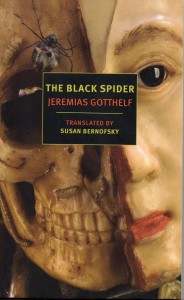Book Review: The Black Spider by Jeremias Gotthelf
It is a beautiful day in rural Switzerland, sunny and warm–a good day for a christening. As the guests digest the first part of the feast, one of them notices an anomalous piece of wood built into one of the window frames. The infant’s grandfather tells the tale of a cruel feudal lord, a bold woman, the devil…and a black spider.
This tale of terror was written in 1842 by Swiss pastor Albert Bitzius, who wrote under the name of Jeremias Gotthelf. This is a new translation by Susan Bernofsky.
As is common with stories of the time, The Black Spider takes its own sweet time to get started. It begins with a long description of a farm family and their neighbors getting ready for the christening and the subsequent party; if nothing else, it’s a window into the customs of rural Switzerland in the Nineteenth Century. Eventually a chance remark leads into the main action of the story.
It seems that this valley was once under the control of the Teutonic Knights, and the master of the castle makes unreasonable demands of the peasants. At last he asks the impossible, and the farmers despair. A mysterious stranger offers to help them out, and it sounds too good to be true. This dark-skinned and red-haired stranger is of course the Devil, and he’ll help them out in exchange for one unbaptized child. They cavil, and it is the bold wife of one who finally agrees, the deal sealed with a kiss on her cheek.
The Devil is as good as his word, helping move a forest from one mountain to another. But this is a horror story, and a deal with the Devil never ends well. Soon a child is about to be born, and the black hickey on Christine’s cheek begins to grow and sprout “legs” like a spider, reminding her to give the Devil his due. Naturally, the villagers decide that they don’t want to give a baby to the Prince of Darkness
Christine is thwarted once and again, and the black spider appears for the first time, bringing disaster to the valley. Now Christine’s own sister-in-law is fast approaching her travail, and this time the villagers are convinced it might be a good idea to give over. The ensuing events release the full power of the black spider.
The monster is finally sealed by the self-sacrifice of a pious woman, but the story isn’t over yet. An impious jerk releases the black spider once more, and the valley is nearly depopulated before it is put back into the wood. Now only the piety and faith in God of the farm family keeps the creature confined.
The horror of the tale is enhanced by the framing; a sunny day of happiness and feasting, and the grandfather’s matter of fact telling. (There are a couple of spots where he’s clearly embellishing, however–he describes more than one scene where there were no survivors to give details.)
There are a few things that might not sit well with modern readers; Christine is essentially punished for having more gumption than was proper for a woman. There’s a certain amount of classism; servants must be firmly controlled. And while God’s power is effective against the black spider, it’s really noticeable that no Heavenly intervention comes to help the peasants against their overlord–it only steps in to directly thwart the powers of Hell.
Recommended to horror fans who don’t mind a leisurely pace and strong religious themes.

